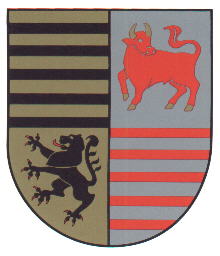Elbe-Elster: Difference between revisions
Jump to navigation
Jump to search
Knorrepoes (talk | contribs) m (Text replace - "'''Origin/meaning :'''<br/>" to "====Origin/meaning====") |
Knorrepoes (talk | contribs) m (Text replace - "|width="15%"|50 px|right |} " to "|width="15%"|50 px|right |}<seo title="Wappen, Gemeindewappen" /> ") |
||
| Line 3: | Line 3: | ||
|width="70%" align="center" |'''Heraldry of the World<br/>Civic heraldry of [[Germany]] - [[Deutsche Wappen|Deutsche Wappen (Gemeindewappen/Kreiswappen)]]''' | |width="70%" align="center" |'''Heraldry of the World<br/>Civic heraldry of [[Germany]] - [[Deutsche Wappen|Deutsche Wappen (Gemeindewappen/Kreiswappen)]]''' | ||
|width="15%"|[[File:Germany.jpg|50 px|right]] | |width="15%"|[[File:Germany.jpg|50 px|right]] | ||
|} | |}<seo title="Wappen, Gemeindewappen" /> | ||
'''ELBE-ELSTER (EE)''' | '''ELBE-ELSTER (EE)''' | ||
Revision as of 19:16, 5 November 2012
| Heraldry of the World Civic heraldry of Germany - Deutsche Wappen (Gemeindewappen/Kreiswappen) |
ELBE-ELSTER (EE)
State : Brandenburg
Additions : 1993 Bad Liebenwerda, Finsterwalde, Herzberg
Origin/meaning
The arms were granted on April 24, 1995.
The lion in the arms is taken from the arms of the County Meissen, as the Southern part of the district historically belonged to Meissen. The bull is the symbol for the Niederlausitz area in which part of the district is situated. The black bars are derived from the original 12th century arms of the County Sachsen-Wittenberg. The area around (Bad) Liebenwerda historically belonged to Sachsen (first S-Wittenberg, later S-Meissen). The red bars represent Brandenburg and are allegedly the oldest arms for the territory of Brandenburg.
Literature : Linder and Olzog, 1996

